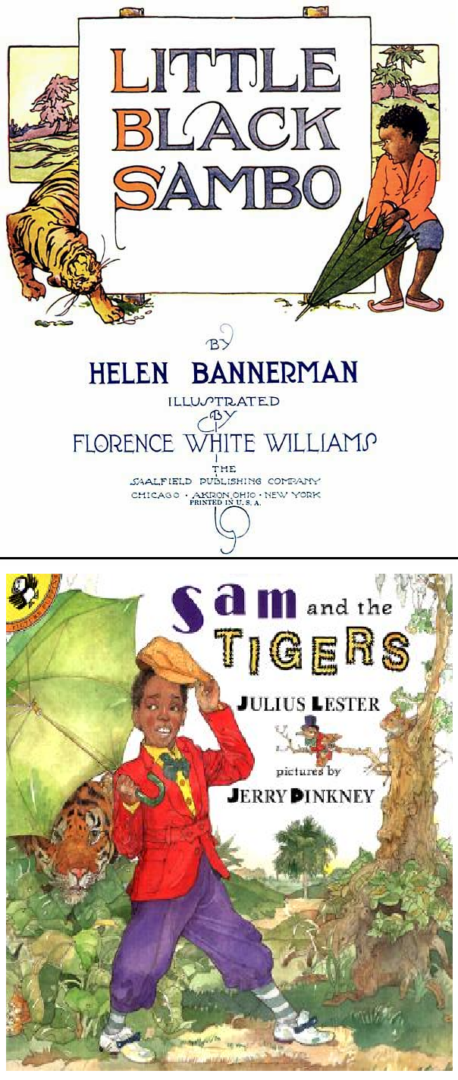

African American History Month–Then and Now
Little Black Sambo and Sam and the Tigers
Racial Sensitivity in the Picture Book
In 1899, Helen Bannerman wrote what some consider a classic picture book called The Story of Little Black Sambo and in 1996, Julius Lester and illustrator Jerry Pinkney teamed up to write what is considered by many to be a less divisive and more racially sensitive take on the original. With a very fresh and modern approach in both art and narrative, their book called Sam and the Tigers is a retelling of Ms. Bannerman’s original. But between the two versions is not merely the divide of a time lapse, but a cultural awakening to a stereotyping of black culture in art and language in the original that many would find offensive.
Mr. Lester points out in the notes at the back of Sam and the Tiger that the use of the name “Sambo” has had a racially negative connotation since the 17th century. Combined with this are Little Black Sambo’s illustrations having a seemingly exaggerated illustration of African facial features. Yet Mr. Lester NEVER hints that there was racist intent in Ms. Bannerman’s creation. In fact, both Mr. Lester and Mr. Pinkney regarded Sambo as a hero when THEY read the book as children. It was HOW he was depicted that “took away his hero status”, says Mr. Lester.
I invite you to read BOTH and make your own informed decision.
Like many of my readers, I grew up with the first and came to the second retelling as an adult. “Little Black Sambo” is, as one of its publishers put it, “a window on the past”, and when he read it to his young boys and asked what they thought, “they said they thought Sambo was a hero and marveled at his bravery.”
But in rereading one and reading the other, for the first time through the eyes of a person in the 21st century, the original AND the retelling could also be seen as a book on how to outwit BULLIES through smarts, as the use of one’s wits can and does outdo brute strength. Now that is a very timely topic for today!
The story, in both versions, is one of a young boy waylaid by tigers and commandeered out of his clothing, shoes and umbrella, yet ultimately triumphs to collect the tigers’ remains that dissolves into butter as the tigers battle over WHICH is the FINEST. The purloined clothing is discarded when they chase each other’s tails around a tree at warp speed and won’t let go of one another. The fine meal of pancakes perfectly topped with the tiger butter provides the satisfying ending.
I mentioned Sambo/Sam as hero and bully defeater a bit ago. A fine example of this is Sambo and Sam’s redirection of two of the tigers as they attempt to EAT him despite his proffering of clothing. Each in turn says why would a TIGER have need of Sambo/Sam’s shoes OR umbrella? The coy suggestion is made that the shoes may be just the ticket for an EAR ORNAMENT. And his TAIL, it is suggested, could use the young boys’ umbrella, as decorating this tiger. Sam, in Sam and the Tigers, also reminds the tiger that eating a boy could drive up his CHOLESTEROL!! Brilliant bully deflection!
For that is what these tigers are in a way; they are big, striped bullies that strong-arm Sambo in the original and Sam in the retelling, out of their clothes, shoes, and umbrella. Sambo is seen in the original as a South Indian child, while in Sam and the Tigers, he is an inhabitant of a mythical place called Sam-sam-sa-mara where EVERYBODY is called Sam and there is no divide because of labels. “What a wonderful world!” as Louis Armstrong put it in song!
Sam and the Tigers depicts Sam as very much his own person and quite assertive as he picks out the clothes he chooses to wear under his parent’s wary eye. Sam chooses his duds carefully and colorfully from a variety of sellers that possess hilarious names such as “Mr. Elephant’s Elegant Habiliments” and “The Feline’s Finest Finery.” Habiliments is definitely on the “let’s look it up” list. Further inquiry is always good in a picture book.
Jerry Lester lets his character in his retelling come through using the sounds and voice of “southern black storytelling” and it is this flavor that makes it a perfect read aloud.
Jerry Lester points out that many people avoided the original for fear of being termed racist, but on reflection, he says something that stuck with me. “Yet what other story had I read at age seven and remembered for fifty years?” Great point! For in the end it is the heroic and imaginative world that children enter into, created for Sambo/Sam by Helen Bannerman and Julius Lester and Jerry Pinkney, that will, like all classics, stand the test of time.
